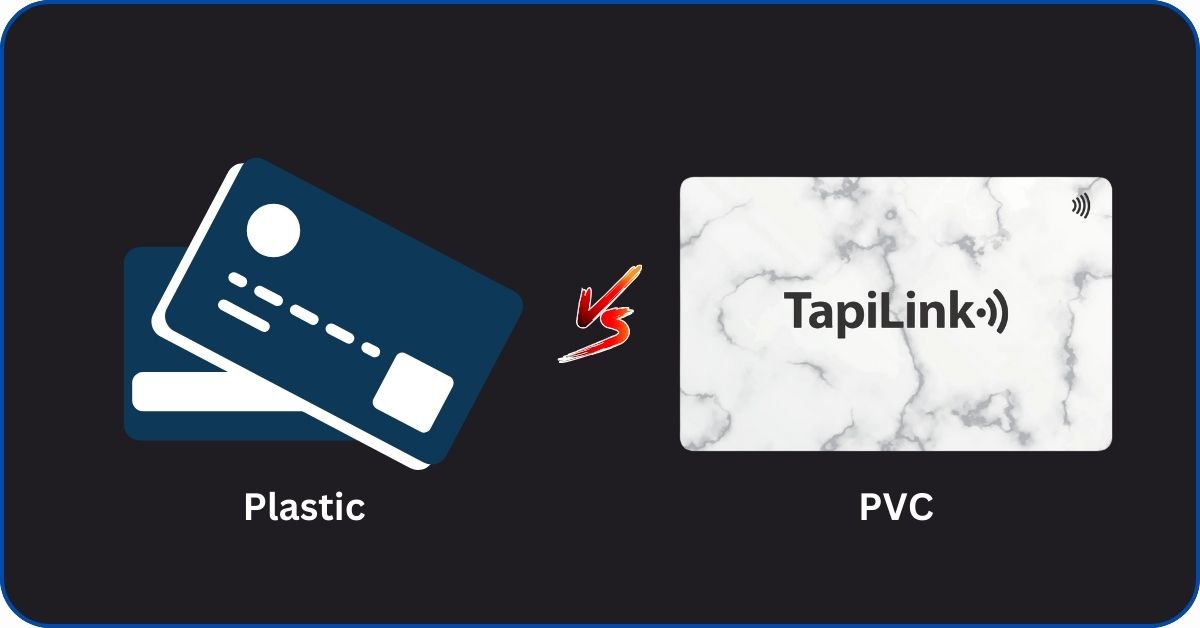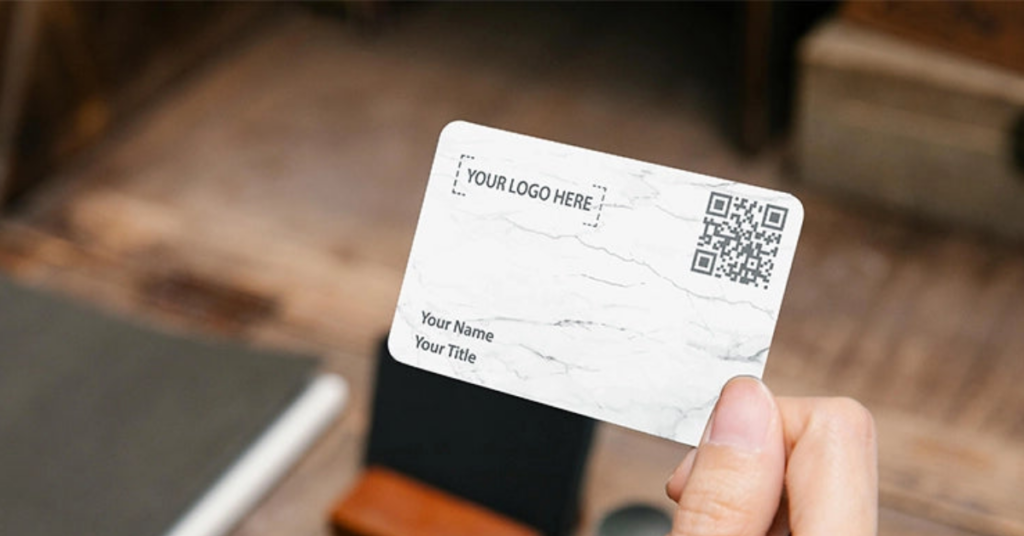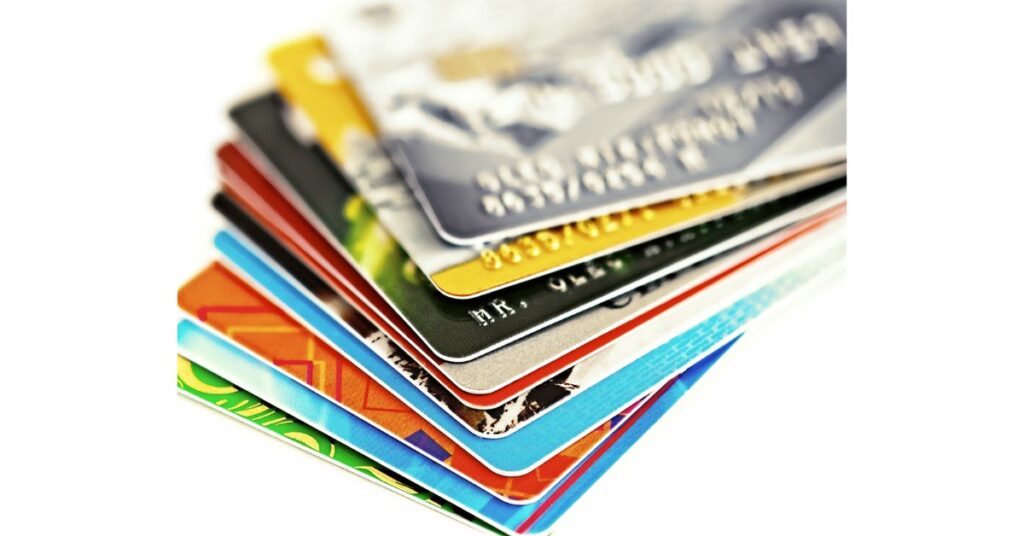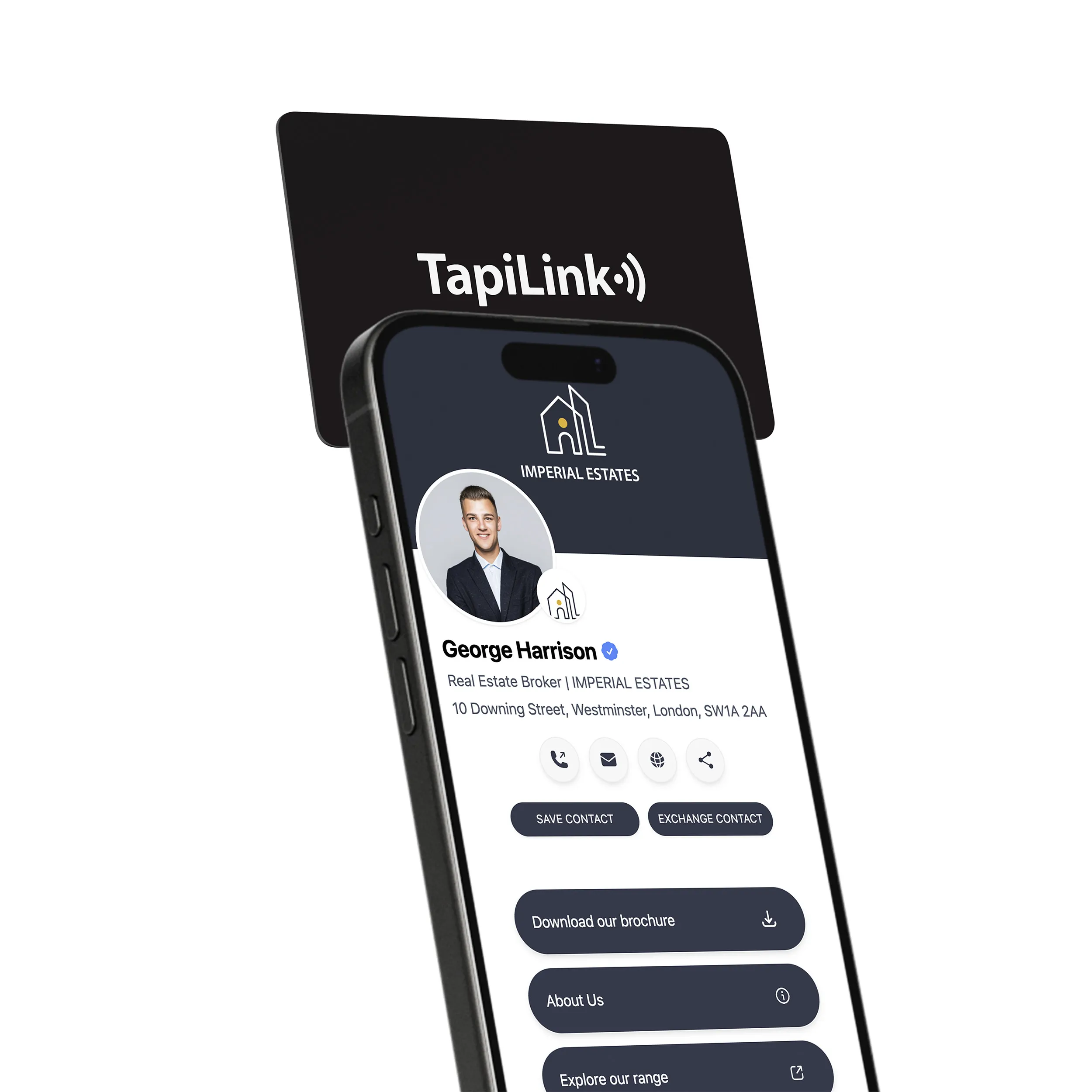Subscribe To Our Newsletter
Join our 50,000+ happy customers
[mc4wp_form id=""]
We’ll Design 🎨 Your Card For Free!
Free Next Day 📦 Delivery in UK
We Ship Worldwide 🌎 ✈️

The difference between PVC and plastic cards lies in their material composition and use cases. PVC cards, made from polyvinyl chloride, are widely used for applications that demand durability and high-quality printing, such as ID badges and credit cards. Meanwhile, plastic cards refer to a broader category, including materials like PET and ABS, which are often chosen for temporary or cost-sensitive purposes like gift cards or loyalty cards. Studies show that 90% of government-issued ID cards use PVC because of its strength and ability to retain color over time.
Choosing the right card can save costs and reduce waste while improving functionality. If you’re looking for the perfect blend of quality, eco-friendliness, and style, TapiLink has you covered. Our customizable card solutions make it easy to meet your specific needs while keeping sustainability in mind.

PVC, or Polyvinyl Chloride, is a type of plastic that stands out for its durability and flexibility. Businesses and organizations worldwide commonly use this material to produce ID cards, credit cards, and membership cards. Its durability and ability to maintain quality over time make it a popular choice.
A significant advantage of PVC Business cards is their longevity. Studies show that PVC cards can last up to 5-7 years with regular use, which is significantly longer than standard plastic cards. This durability is due to the strong molecular structure of polyvinyl chloride, which protects the cards from bending, cracking, or fading. PVC cards withstand daily swipes and years of wallet use, maintaining durability and reliability under constant pressure.
Another key feature of PVC cards is their ability to produce sharp, high-quality images. Advanced dye-sublimation printing is used on PVC cards, producing vibrant colors and crisp text. These cards are ideal for applications requiring clear and professional branding or identification, such as employee badges or loyalty cards.
In terms of versatility, PVC cards are compatible with technologies like magnetic strips, barcodes, and embedded chips, making them an excellent choice for businesses needing multifunctional cards. Furthermore, with an annual production of over 3 billion PVC cards worldwide, they are a trusted and widely available solution for card-based systems.
The durability and quality of PVC cards come at a slightly higher cost compared to standard plastic cards. However, their longevity often offsets this initial expense, saving businesses money in the long run by reducing the need for replacements.

Manufacturers create plastic cards using various materials, including PET (Polyethylene Terephthalate), ABS (Acrylonitrile Butadiene Styrene), and PVC (Polyvinyl Chloride). However, not all plastic cards use PVC. PET and ABS plastics serve different purposes, such as gift, loyalty, and membership cards. PET cards are flexible and recyclable, making them eco-friendly. ABS cards are strong and heat-resistant, suitable for applications needing rigid cards. PVC offers strength and durability, while PET and ABS excel in specific use cases.
The flexibility of plastic cards makes them an excellent choice for a wide variety of industries. Experts predict the global plastic card market will reach USD 14.7 billion by 2026, growing at a 7.6% CAGR from 2019. Increasing use across sectors like retail and healthcare and rising demand for contactless payment solutions drive this growth.
In terms of cost, plastic cards are generally more affordable than other types of materials like metal or paper cards. For businesses, this affordability allows them to order large quantities of cards without breaking the bank. Additionally, businesses can easily customize plastic cards with logos, designs, and QR codes, making them perfect for brand promotion. Plastic gift cards alone accounted for over USD 360 billion in sales in the United States in 2022, underscoring their importance in consumer purchasing behavior.
Moreover, plastic cards are lightweight, making them easy for customers to carry and use. They are versatile and can be employed in various applications such as customer loyalty programs, promotional events, and membership rewards. In fact, more than 60% of consumers in the U.S. hold at least one loyalty card, and many businesses use plastic loyalty cards as a tool to increase customer retention and encourage repeat purchases.
Although many consider PVC cards the gold standard for durability, PET and ABS plastic cards are gaining popularity for their lighter weight, environmental benefits, and affordability.As businesses strive to reduce their environmental impact, the use of recyclable materials like PET has seen a rise in popularity, with plastic card recycling rates steadily increasing each year.
In summary, plastic cards are a versatile and cost-effective solution for a wide range of applications. They are lightweight, customizable, and widely used across multiple industries, including retail, hospitality, and healthcare. With the market for plastic cards continuing to grow, businesses can choose the material that best suits their needs, whether it’s PVC, PET, or ABS. Understanding the differences between these materials and their specific benefits allows companies to make an informed decision about which type of plastic card is right for their business.
When choosing the right card material for your needs, understanding the key difference between PVC and plastic cards is essential. These materials, while both classified as types of plastic, have distinct characteristics that can influence their performance, cost, and environmental impact. Below is a detailed comparison of the two materials.
PVC (Polyvinyl Chloride) is one of the most widely used plastics for cards. It is a synthetic polymer that offers high durability and flexibility, making it an ideal choice for items like ID cards, credit cards, and membership cards. PVC cards are made from a material that is rigid, stable, and can be easily customized with high-quality prints.
On the other hand, plastic cards are a broader category. While PVC is a type of plastic, other materials, such as PET (Polyethylene Terephthalate), ABS (Acrylonitrile Butadiene Styrene), and Polycarbonate, are also used to make cards. PET cards, for example, are becoming increasingly popular due to their recyclability and slightly lower production costs. These plastic cards offer flexibility, strength, and are commonly used for things like gift cards and loyalty cards.
One of the biggest advantages of PVC cards is their exceptional durability. PVC cards are highly resistant to wear and tear, scratches, and water exposure. Studies show that PVC cards have a longer lifespan, often lasting between 3 to 5 years or more, depending on usage. This makes them perfect for cards that are subject to frequent handling, such as ID badges or membership cards.
In comparison, plastic cards made from materials like PET are not as durable. While they still provide a good level of strength, they are not as resistant to abrasion and can lose their integrity over time if exposed to harsh conditions. PET cards, for instance, typically last between 1 to 3 years, making them suitable for short-term use, such as promotional or gift cards.
Here’s a simple breakdown of durability:
| Card Type | Average Lifespan | Scratch Resistance | Water Resistance |
| PVC | 3 to 5 years | High | Excellent |
| Plastic | 1 to 3 years | Moderate | Moderate |
While PVC cards offer excellent durability, they do come with some environmental concerns. PVC is non-biodegradable, which means it can take hundreds of years to break down in landfills. Additionally, PVC production involves the release of harmful chemicals like dioxins, which have negative effects on the environment. However, PVC cards are recyclable in specific programs, though these programs are not always widely available.
On the other hand, plastic cards made from PET are much more eco-friendly. PET is a recyclable material, and studies show that approximately 60% of PET plastic is recycled globally. This makes PET a better choice for businesses and individuals looking to reduce their environmental footprint. Moreover, PET cards have a lower carbon footprint during production compared to PVC.
| Material | Recyclability Rate | Environmental Impact |
| PVC | 20% (recycled) | High (non-biodegradable) |
| PET | 60% (recycled) | Low (biodegradable and recyclable) |
The cost of PVC cards tends to be higher due to the quality of the material and its durability. On average, PVC cards cost between $0.30 and $1.00 per card, depending on quantity and customization. The high-quality printing options available for PVC cards-such as full-color printing or embossing-also contribute to the increased cost.
In comparison, plastic cards made from materials like PET are generally more affordable, with prices ranging from $0.10 to $0.50 per card. This makes plastic cards a cost-effective solution for temporary cards or mass-produced items like gift cards. However, the lower production cost comes at the expense of long-term durability and quality.
| Card Type | Price Range (per card) | Printing Quality | Durability |
| PVC | $0.30 to $1.00 | High (full-color) | Long-lasting |
| Plastic | $0.10 to $0.50 | Moderate (simple prints) | Shorter lifespan |
Choosing between PVC cards and plastic cards ultimately depends on your specific needs. If you want long-lasting, high-quality cards for membership, ID cards, or digital business cards, choose PVC cards for their durability and excellent printing capabilities. However, if you’re working on a budget and need temporary cards or gift cards, plastic cards made from PET or other materials offer an affordable and eco-friendly solution.
Here’s a comprehensive table summarizing all the key differences between PVC cards and plastic cards:
| Criteria | PVC Cards | Plastic Cards |
| Material Composition | Made from Polyvinyl Chloride (PVC) – a specific type of plastic | Made from various plastics, including PET, ABS, Polycarbonate, etc. |
| Durability | High durability; lasts 3 to 5 years or more | Moderate durability; lasts 1 to 3 years |
| Scratch Resistance | High resistance to scratches and wear | Moderate resistance to scratches |
| Water Resistance | Excellent resistance to water and moisture | Moderate resistance to water |
| Environmental Impact | Non-biodegradable; harmful chemicals like dioxins released during production | Recyclable (especially PET) with about 60% of PET recycled globally |
| Recyclability | Low (about 20% of PVC is recycled) | High (about 60% of PET is recycled) |
| Cost | Higher cost, usually between $0.30 to $1.00 per card | Lower cost, usually between $0.10 to $0.50 per card |
| Printing Quality | High-quality printing (full-color, embossing options) | Moderate printing quality (simpler prints) |
| Lifespan | 3 to 5 years or more | 1 to 3 years |
| Best Use | Ideal for long-lasting cards such as ID cards, membership cards, credit cards | Suitable for temporary cards, gift cards, loyalty cards |
This table clearly highlights the differences between PVC cards and plastic cards, helping you make an informed decision based on your requirements for cost, durability, environmental concerns, and quality.
When deciding between PVC cards and plastic cards for your business needs, it’s important to consider several factors including durability, cost, environmental impact, and the specific application of the cards. The right choice depends on your requirements for card lifespan, budget constraints, and sustainability goals. Below, we break down these aspects to help guide your decision.
PVC cards, made from Polyvinyl Chloride, are renowned for their robustness and resistance to wear and tear. They typically last 5 to 7 years under normal conditions, making them ideal for frequently used applications like ID badges and membership cards. Their ability to withstand scratches and fading helps preserve the card’s information and appearance.
In contrast, plastic cards made from PET or ABS are typically used for shorter-term applications. These are ideal for scenarios like promotional cards or temporary event passes, where long-term use is unnecessary. They typically have a lifespan of 1 to 3 years and are more prone to wear compared to PVC cards.
Plastic cards are often more cost-effective, particularly when produced in large quantities for short-term use. The cost range for plastic cards can be as low as $0.10 to $0.30 per card, which is appealing for businesses managing budget constraints and needing high volumes of cards for promotions or events.
However, the environmental impact of card materials is also a crucial factor. While PVC cards offer longer durability, they are less eco-friendly due to challenges in recycling. Conversely, PET cards are popular for their recyclability, aligning with the demand for sustainable business practices. Although less durable than PVC, their lower environmental footprint makes them ideal for businesses prioritizing green initiatives.
When choosing between PVC and plastic cards, weigh these factors based on your business needs and short- and long-term implications.
When selecting between PVC cards and plastic cards, the right material can make a significant difference in both the short and long term. The material you choose affects cost, branding, environmental impact, and durability, all of which are crucial for your business. Let’s explore how making the right choice can benefit your business and help you stand out.
Cost is always a major factor in business decisions. PVC cards offer premium quality and are known for their durability. While more expensive upfront, typically $0.50 to $1.00 per card, they are long-lasting and cost-effective over time. These cards can last 2-3 years, which reduces the need for frequent replacements. In contrast, plastic cards made from PET or ABS are affordable, costing $0.10 to $0.30 per card. However, their shorter lifespan, around one year, makes them ideal for temporary cards, gift cards, or promotional giveaways.
Choosing PVC cards means you are making a long-term investment, as their durability means less frequent reorders. On the other hand, plastic cards can be a budget-friendly option for businesses that need cards for short-term use.
Your business cards or ID cards are more than just contact information—they represent your brand. The quality of the material plays a huge role in the perception of your business. PVC cards provide superior print quality and a premium finish. The glossy surface of PVC cards allows for vibrant colors and detailed designs, making your cards stand out. This high-quality material is perfect for businesses that want to convey a professional and high-end image. PVC cards also offer features like embossing, debossing, or special finishes, which make your cards feel unique and memorable.
While plastic cards are also effective for branding, they don’t have the same premium feel. They are great for simpler designs and more budget-conscious businesses. However, they don’t provide the same high-end look and long-lasting impression as PVC cards. If your business aims to appear premium, PVC cards create a lasting impression on your customers.
In today’s world, sustainability is important. Plastic cards, especially those made from PET, are recyclable, helping to reduce the overall waste. PET plastic has a high recycling rate, with 30% of PET plastic being recycled in the U.S. alone. If you are looking for an environmentally friendly option, plastic cards are a great choice. Additionally, some companies offer biodegradable PVC or recycled PET options, reducing your footprint while maintaining high quality.
On the other hand, PVC cards are less environmentally friendly due to their difficulty in recycling. Only about 2% of PVC cards are recycled. However, if you are concerned about sustainability, some businesses offer eco-conscious PVC cards made from recycled materials or biodegradable options. By choosing eco-friendly options, you show customers your business cares about the environment, a key selling point.
Durability is a critical factor when choosing between PVC cards and plastic cards.
If you expect frequent handling, wear, or exposure to harsh conditions, choose PVC cards. They resist scratches, bends, and water damage effectively. They typically have a lifespan of 2-3 years, which makes them ideal for membership cards, ID cards. In comparison, plastic cards are less durable and are more likely to fade or bend over time. They usually last only 1 year and are more suited for short-term uses like loyalty cards or promotional materials.
When durability is a priority, PVC cards ensure your cards stay in great condition and your branding remains intact longer. They provide better protection against damage, ensuring that your cards can withstand daily use.
Choosing the right material can also impact your brand image and how your customers perceive you. High-quality PVC cards convey a sense of professionalism and trustworthiness. Customers are more likely to trust a business using premium materials, showing an investment in quality and longevity. On the other hand, people perceive plastic cards as affordable but less durable, which may reduce trust.
If you aim to build trust and portray a high-end business, investing in PVC cards can establish a premium image. Customers will appreciate the quality of your cards, which can lead to increased loyalty and business growth.
When choosing between PVC cards and plastic cards, there are several factors to consider. If you want premium quality, long-lasting durability, and a strong brand image, PVC cards are the better choice. They might come at a higher initial cost, but their durability and premium feel make them a smart investment. On the other hand, if you need a more budget-friendly option for temporary uses, plastic cards are a good alternative.
Both materials offer benefits depending on your business needs.
By considering factors such as cost, branding, environmental impact, and durability, you can align with your business goals. Whether choosing PVC cards for long-term use or plastic cards for short-term solutions, making an informed decision aids your success.
When it comes to choosing between PVC and plastic cards, the choice is clear for longevity and a polished brand appearance. PVC cards offer superior durability and a high-quality finish, enhancing your brand’s perception and conveying professionalism. At TapiLink, we specialize in premium, customizable card solutions tailored to your business needs, with a focus on sustainability. Have you considered how your business cards reflect on your company’s image?
Choosing the right material for your business cards is both practical and strategic, helping build lasting client relationships. Why not contact TapiLink today to explore how our tailored card solutions can elevate your professional presence? Let us help you make a lasting impression that resonates with your brand values and visions.
PVC cards are made from durable polyvinyl chloride, suited for frequent use and harsh conditions. In contrast, plastic cards use cost-effective polyethylene terephthalate (PET). While PET cards are cheaper and lighter, they are less resistant to wear and tear compared to PVC.
PVC cards tend to be more expensive than their plastic counterparts. This cost difference is attributed to the material properties of PVC, which offer enhanced durability and resistance to environmental factors. PVC’s durability makes it ideal for frequently handled or outdoor cards, justifying its higher cost.
Yes, plastic cards made from PET are recyclable. PET is a type of plastic commonly used in consumer goods and can be processed through standard recycling facilities. Recycling PET cards helps reduce waste and supports sustainability efforts. This makes PET cards an eco-friendly option, appealing to environmentally conscious businesses and consumers.
The choice between PVC and plastic cards for business cards depends on the intended use and budget. PVC cards are superior for durability and a professional appearance, making them suitable for high-quality, long-lasting business cards. However, for short-term applications or when cost is a major consideration, plastic cards provide a viable, more affordable alternative.
Join our 50,000+ happy customers
Copyright © 2025 TapiLink, made with ❤️ in United Kingdom. TapiLink is a trading name of SERVICEWORLD LIMITED (company number: 13239157), whose registered office is at 34 Green Street, London, England, E7 8BZ

Subscribe to our newsletter below and get 10% exclusive discount on your first order.